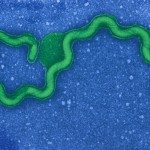Lien vers Pubmed [PMID] – 27864172
Appl. Environ. Microbiol. 2017 Feb;83(3)
Leptospira interrogans is the agent of leptospirosis, a reemerging zoonotic disease. It is transmitted to humans through environmental surface waters contaminated by the urine of mammals chronically infected by pathogenic strains able to survive in water for long periods. Little is known about the regulatory pathways underlying environmental sensing and host adaptation of L. interrogans during its enzootic cycle. This study identifies the EbpA-RpoN regulatory pathway in L. interrogans In this pathway, EbpA, a σ(54) activator and putative prokaryotic enhancer-binding protein (EBP), and the alternative sigma factor RpoN (σ(54)) control expression of at least three genes, encoding AmtB (an ammonium transport protein) and two proteins of unknown function. Electrophoresis mobility shift assay demonstrated that recombinant RpoN and EbpA bind to the promoter region and upstream of these three identified genes, respectively. Genetic disruption of ebpA in L. interrogans serovar Manilae virtually abolished expression of the three genes, including amtB in two independent ebpA mutants. Complementation of the ebpA mutant restored expression of these genes. Intraperitoneal inoculation of gerbils with the ebpA mutant did not affect mortality. However, the ebpA mutant had decreased cell length in vitro and had a significantly lowered cell density at stationary phase when grown with l-alanine as the sole nitrogen source. Furthermore, the ebpA mutant has dramatically reduced long-term survival ability in water. Together, these studies identify a regulatory pathway, the EbpA-RpoN pathway, that plays an important role in the zoonotic cycle of L. interrogans IMPORTANCE: Leptospirosis is a reemerging disease with global importance. However, our understanding of gene regulation of the spirochetal pathogen Leptospira interrogans is still in its infancy, largely due to the lack of robust tools for genetic manipulation of this spirochete. Little is known about how the pathogen achieves its long-term survival in the aquatic environment. By utilizing bioinformatic, genetic, and biochemical methods, we discovered a regulatory pathway in L. interrogans, the EbpA-RpoN pathway, and demonstrated that this pathway plays an important role in environmental survival of this pathogen.

